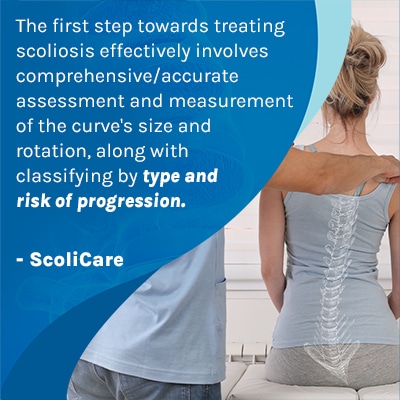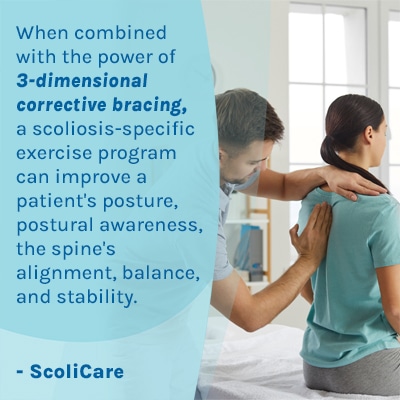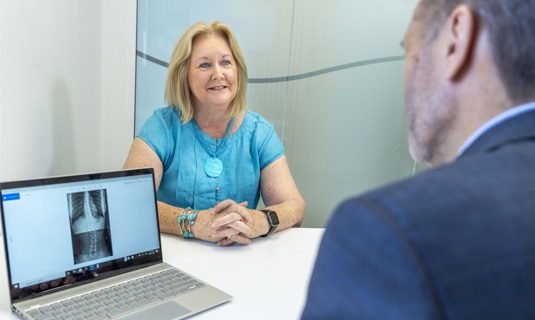Scoliosis can be highly responsive to treatment, particularly when conditions are diagnosed and treated early. The different types of scoliosis can have distinct treatment needs, and patients need to decide how to respond with treatment: a decision that can shape future spinal health.
Scoliosis is a progressive spinal condition with wide-ranging severity levels and different types. Different condition types are determined by causation and can have distinct symptoms; treatment plans need to be customized around these important factors.
Before getting to the specific types of scoliosis, let’s talk generally about the condition.
What is Scoliosis?
There are currently close to seven million people living with scoliosis in the United States, and as the condition is most commonly diagnosed in children and scoliosis progression is triggered by growth, childhood scoliosis is usually the focus of scoliosis-talk (1).
Adults, however, are also affected by scoliosis and can develop it at any age (2, 3)
Scoliosis causes the spine to develop an unnatural and unhealthy lateral (sideways-bending) curvature, and as a 3-dimensional condition in need of 3-dimensional correction, the spine also twists.
The spine’s healthy curves give it an ‘S’ shape when viewed from the sides and make it straight when viewed from the front or back; if the spine loses one or more of its healthy curves, the spine’s biomechanics are disrupted.
Scoliosis causes the spine’s structure to change because its vertebrae are becoming unnaturally tilted which changes the spine’s position; a factor that needs to be determined during assessment and diagnosis is the type of scoliosis involved as this will shape its treatment needs.
From the side view, the spine should have three healthy curves, one in each of its main sections: the cervical spine (neck), thoracic spine (middle/upper spine), and the lumbar spine (lower spine). This presentation of the spine can be altered in patients with scoliosis, sometimes coming before or after the scoliosis. To determine the impact of this one needs a detailed 3D evaluation of the spine, ensuring that all aspects of spine health are covered.
Types of Scoliosis
 The first step towards treating scoliosis effectively involves comprehensive/accurate assessment and measurement of the curve’s size and rotation, along with classifying conditions by type and risk of progression.
The first step towards treating scoliosis effectively involves comprehensive/accurate assessment and measurement of the curve’s size and rotation, along with classifying conditions by type and risk of progression.
Without accurate assessment, the best potential outcome can’t be determined and achieved.
Idiopathic Scoliosis
Idiopathic scoliosis has no known cause.
Idiopathic scoliosis is generally diagnosed in children between the ages of 10 and 12, but it can also affect children between the ages of 4 and 10 as juvenile scoliosis and babies up to 3 years of age as infantile scoliosis.
The most common type of idiopathic scoliosis is adolescent idiopathic scoliosis that involves children from the ages of 10 to 18; it’s most often diagnosed around 11 or 12 in girls and later in boys (1).
Adolescent idiopathic scoliosis affects approximately 4 percent of children between the ages of 10 and 18 (1).
Scoliosis symptoms can vary patient to patient and are shaped by factors like severity, curvature location, and patient age; common symptoms of idiopathic scoliosis include postural changes, shoulder humping, and pain (adult scoliosis) (2).
While rare, if scoliosis is particularly severe, atypical, and/or is left untreated, it can cause related complications such as lung and heart problems.
When patients are treated proactively, however, many of these symptoms and increasing condition effects can be avoided.
Scoliosis progression is mainly triggered by growth, so when idiopathic scoliosis is diagnosed during adolescence, this age group is at risk for rapid progression due to growth spurts occurring during puberty (1, 4).
Adult Scoliosis
Adults can be affected by pre-existing scoliosis (usually adolescent scoliosis in adults), also known as Adolescent Scoliosis in Adult (ASA) and degenerative de novo scoliosis (DDS) (2, 3).
ASA cases may or may not have been previously diagnosed during adolescence so working towards determining if the adult scoliosis is pre-existing or a new scoliosis is the first step.
In cases that were diagnosed during adolescence, assessment is easier because past X-ray images can be compared to current ones, but in cases where the scoliosis is discovered during adulthood, it’s more challenging to determine whether or not the scoliosis is pre-existing or has developed with no prior history as de novo scoliosis.
Pain and postural changes are the most common symptoms of scoliosis in adults, and continued progression can be an issue due to spinal degeneration occurring over time.
Degenerative de novo scoliosis most commonly affects females over the age of 45 because it’s caused by age-related spinal degeneration that tends to increase with age and is always progressive; the main symptom of degenerative scoliosis is lower back pain (2, 3).
While in the past, the scope of adult scoliosis treatment was somewhat limited to prescription pain medications and surgery, innovation and advancements in adult scoliosis care include bracing and exercise rehabilitation programs, so there is always hope for improvement.
Neuromuscular Scoliosis
Neuromuscular scoliosis can be severe as it’s caused by a pre-existing underlying neurological or muscular disorder like cerebral palsy, spina bifida, muscular dystrophy, or spinal muscular atrophy.
So while most cases of scoliosis are idiopathic, neuromuscular scoliosis involves a known cause: an issue with the muscles and nerves that facilitate healthy posture and movement.
As neuromuscular scoliosis can be particularly severe, early detection and effective management is key, and nonsurgical treatment options have the goal of slowing progression and improving a patient’s quality of life.
While some cases require surgical treatment, those that maintain a certain degree of neuromuscular control over their torso may be responsive to custom-designed scoliosis bracing and scoliosis-specific exercise programs.
Treating Scoliosis Without Surgery
When possible, treating scoliosis without surgery is almost always going to be better for the spine’s overall health and function.
Surgical treatment involves spinal fusion and is invasive.
While there are never treatment guarantees, particularly when scoliosis is diagnosed while still mild, there are fewer limits to what conservative treatment options can achieve, without the risks that surgical treatment carries.
Scoliosis bracing and scoliosis-specific exercise are key nonsurgical treatment disciplines.
3-Dimensional Scoliosis Bracing
Observing and understanding the limitations of traditional scoliosis bracing led to the modern and innovative design of 3-dimensional bracing.
The results of mirror image rehabilitation showed how treatment success can be contingent on a plan’s ability to impact a patient’s scoliosis and posture in all three dimensions; a main limitation of traditional scoliosis bracing is that it’s only 2-dimensional.
With cutting-edge scanning software, a patient’s individual posture and condition type can be factored into a brace’s 100-percent custom design, with the goal of improving the postural and structural abnormality in all three planes.
The ScoliBrace® has a Mirror-Image® over-corrective design and harnesses spinal coupling for results, versus traditional 3-point pressure points; this is better for preserving spinal mechanics and strength and can offer an effective means of improving the spine’s alignment and body posture.
The innovative ScoliBrace® can achieve 3-dimensional correction by putting the spine in the most aligned position possible, and when combined with the power of scoliosis-specific exercise and rehabilitation, treatment success is more likely (5).
ScoliBalance : The ScoliCare Approach to Exercise
Specialized scoliosis exercise programs are a key facet of nonsurgical scoliosis treatment in children and adults (5).
While traditional scoliosis treatment questions the value of exercise, scoliosis-specific exercise has proven its place in nonsurgical treatment and in its ability to facilitate scoliosis correction.

There are different types of scoliosis exercise programs: some that are more physical-therapy based and others that are more chiropractic-centered.
Our ScoliCare clinicians have been trained in these different approaches to treating scoliosis with exercise, have extracted the best elements of each approach, and integrated them into a highly-specialized scoliosis-specific exercise program known as ScoliBalance® (5).
ScoliBalance® offers an individualized scoliosis-specific exercise program that can be taught to patients so they are always aware of body position, posture, and spinal alignment, with the goal of sustaining corrective treatment results (5).
Over time, this level of postural awareness can be applied to all daily activities to help hold treatment results, stabilize the scoliosis curve, and cultivate a scoliosis-friendly lifestyle.
Treatment results can never be guaranteed, but ScoliBalance® can help slow/stop curve progression, improve the spine and body’s balance, muscular balance and strength for more support and stability, posture, spinal flexibility, and can reduce the risk of serious falls in older patients (5).
When combined with the power of 3-dimensional corrective bracing, a scoliosis-specific exercise program can improve a patient’s posture, postural awareness, the spine’s alignment, balance, and stability (5).
Conclusion
Here at ScoliCare, our focus is patient-centered. We strive to be leaders in scoliosis innovation, integration, and advancement through research.
Sometimes the timing of treatment is a key element of its success, so one of our many focuses is on education because this is at the heart of early detection.
Diagnosing and starting treatment while progressive conditions are still mild is directly linked to treatment success, and the first step towards a diagnosis is recognizing a need for assessment.
Symptoms of scoliosis will vary based on a number of factors, including the different types of scoliosis but commonly include postural changes and pain.
Customizing effective treatment plans can’t be done without comprehensive and accurate assessment first, and this involves classifying conditions based on type: infantile scoliosis, juvenile scoliosis, adolescent idiopathic scoliosis, adult scoliosis (ASA and DDS), and neuromuscular scoliosis.
Most conditions don’t have a known cause; those that do can be particularly challenging to address and include neuromuscular scoliosis and adult degenerative de novo scoliosis.
ScoliCare clinicians make up a global team of professionals dedicated to the effective and timely treatment of scoliosis for patients of all ages and condition types, but the sooner treatment is started, the more likely success is, so don’t hesitate to reach out for support.
References:
- Weinstein SL. The Natural History of Adolescent Idiopathic Scoliosis. J Pediatr Orthop. 2019 Jul;39(Issue 6, Supplement 1 Suppl 1):S44-S46. doi: 10.1097/BPO.0000000000001350. PMID: 31169647.
- Marty-Poumarat C, Scattin L, Marpeau M, Garreau de Loubresse C, Aegerter P. Natural History of Progressive Adult Scoliosis. Spine. 2007 May 15;32(11):1227-1234. doi: 10.1097/01.brs.0000263328.89135.a6.
- McAviney J, et al. The prevalence of adult de novo scoliosis: A systematic review and meta-analysis. Eur Spine J. 2020 Dec;29(12):2960-2969. doi: 10.1007/s00586-020-06453-0.
- Negrini S, et al. 2016 SOSORT guidelines: orthopaedic and rehabilitation treatment of idiopathic scoliosis during growth. Scoliosis Spinal Disord. 2018 Jan 10;13:3. doi: 10.1186/s13013-017-0145-8. PMID: 29435499.
- Marchese R, Du Plessis J, Pooke T, McAviney J. The Improvement of Trunk Muscle Endurance in Adolescents with Idiopathic Scoliosis Treated with ScoliBrace® and the ScoliBalance® Exercise Approach. J Clin Med. 2024 Jan 23;13(3):653. doi: 10.3390/jcm13030653. PMID: 38337346.


